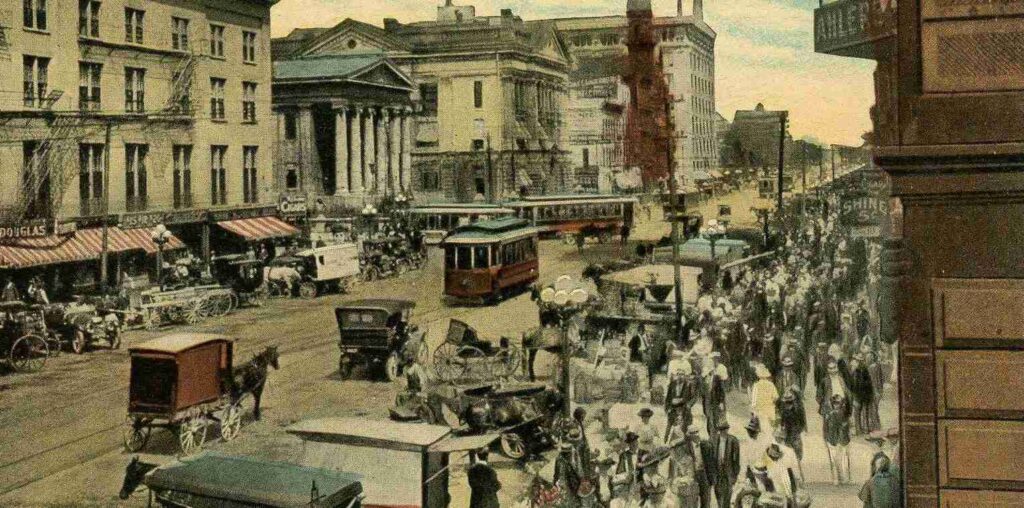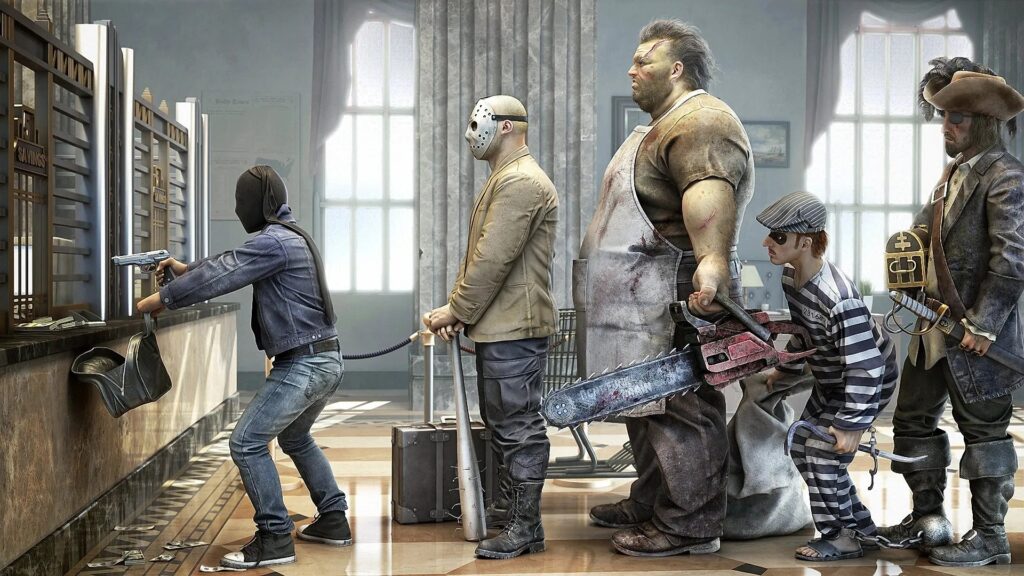In the early 1900s, the city of Dayton was marked by a period of innovation, industrial and commercial growth, and according to the 1900 census, with a population of over 85,000, it was one of the more successful cities in Ohio.
But, along with all that modernization, there was a sinister evil lurking just below the surface – a shadowy figure that came to be known as The Dayton Strangler, giving the city the reputation of being a bad place to be if you were a young lady.
(note: please also see The Cumminsville Murder Zone)
The Murders
Ada Lantz
On a pleasant day mid-October 1900, the family of eleven-year-old Ada Lantz had a small social gathering in their Dayton home. At some point in the evening, the young girl made a brief appearance at the party, and then the adults went back to playing the card games that had so far kept them entertained.
The next time someone would see young Ada was when her body was found in a vault kept behind the family’s house. Her body was badly bruised and mutilated, a fresh wound crossing her face.
It would not be long before the police had their first suspect, a man named Emmons who had been seen standing just outside the Lantz property by a couple of women. He was arrested, but without any direct evidence, the police felt they couldn’t charge him with any crimes. A year later, a second person was arrested after the owner of a popular bicycle shop reported that a young man named Blessing had stolen a bicycle tire. For some reason, when arrested, this fella confessed to Ada Lantz’s murder, however it quickly became clear that he was not the guilty party.
Dona Gilman
When 20-year-old Dona Gilman left her job at the National Cash Register Company, on November 20, 1906, she likely had one thing on her mind. She had written her beau a few days before asking if the two could spend some time together that night. Most nights, Dona would make her way home accompanied by her sister, Fayne, but this night she would be alone. Witnesses saw her board one train, take it a short way then board another that would drop her just a few short blocks from her home. This night, however, she never made it home.
Instead, her body would be found 200 yards from her home. The police were quick to investigate. Dona’s neighbor, a man named Robert Keyes said that he heard what sounded like a struggle coming from the direction of Gilman’s house, although it was eventually determined that she had been killed in another nearby (unoccupied) house before her body was dragged into the bushes and left behind.
Once again, police looked into several suspects, even arresting a few and holding them until it was clear that they were not the guilty party.
Abe Cohan and Anna Markowitz
Abe Cohan, Anna Markowitz and her sister Bertha were walking together near the National Soldiers’ Home on August 4, 1907. When the trio reached a deserted spot in McCabe Park, they stopped to chat when a male figure appeared as if out of nowhere, striking Cohan with a club or baton. When he turned to face his attacker, she was shot twice in the stomach.
Bertha ran away as fast as she could, quickly summoning the sheriff. It didn’t take long for a posse to form and begin searching the area. Cohan was still laying on the ground where he had been shot, barely clinging to life. Thanks to some drag marks, Anna was soon discovered in some nearby bushes, victim to a particularly brutal and vicious assault.
One interesting clue came from a black housekeeper who happened to be near the park at the time of the assault. She reported hearing a woman crying, “Harry! Harry! Oh, Harry!” This led some to believe the killer might be a man named Harry, which was a popular name at the time. However, nobody named Harry was ever connected to the case at all.
Mary Forschner
Mary was a 15-year-old employee of the Kling Tobacco Warehouse (because modern labor laws had yet to be made) when she was attacked and killed.
On January 24, 1909, she left her stepfather’s house with $9 in a deposit book from Dayton Savings and Trust Company, intending to put it in the bank. It is unclear where the girl went, or what all she was up to, but we know that when she didn’t return home by that evening, the family orchestrated a search party looking for her.
For some reason, the police weren’t notified about the girl’s disappearance until around midnight. However, before they could arrive to join the search, Mary’s lifeless body was found in a neighbor’s estate. She had been brutally beaten and raped.
During the police investigation, two important witnesses came forward. One, Sam Morris, said that he heard a scream at approximately six thirty and looked out his window to see a man sitting on a fence. He approached the man only to be threatened with a shotgun. Morris returned to his house, located his own shotgun and returned, only to find that the man had gone.
The other witness, a Mrs. John Scheff, stated that she had gotten off the train near where the body was found only to catch the attention of a dark stranger. Fearful, she took off running toward her home only to find the man running behind her. After she, as quickly as possible, made her way into her house, the man ran off to not be seen again.
The authorities also noted that another similar attack happened later that evening. A young lady named Powers was also attacked, but she found the strength to fight back. Her husband quickly came to her defense, but the assailant managed to escape. The couple did note that he was now badly bruised, and nearly all of his clothing was torn.
Elizabeth Fulhart
On February 7, 1909, Elizabeth Fulhart arrived in Dayton from the suburbs, a young lady in search of gainful employment. The next day, however, she went missing.
A week later, her lifeless body was pulled out of a cistern wrapped in a burlap sack and would soon be identified by her brother.
Unlike the above-mentioned murders, her official cause of death was a bit harder to determine. There was no bruising, defensive wounds … there was nothing in her outward appearance that would hint at the cause of death. This led some to speculate that she had been poisoned, or perhaps drowned in the sack she had been found in.
Her body was fully dressed, but (the coroner noted) she wasn’t wearing any underwear. This led the authorities to wonder if she had been sexually assaulted? And did her killer re-dress her afterwards?
Dayton, 1909
On February 9, 1909, The Dayton Herald in an under-the-fold headline that read “Dorothy Dale Says Dayton is Awakened to Only One Kind of Civic Conscience” pointed out that the city of Dayton was getting a bit of an image problem. Dale, a “woman writer” from the Cleveland Press notes how the city has been attracting young people, including women, with promising jobs, mostly in manufacturing and industrial building. She talks of “handsome bridges” being built, of new projects such as the one to lagoon part of the Miami River, offering new river-front opportunities to the city’s elite who live along its banks. It’s clear to her that the city was flexing, catering to the social and financial elite, making the city sound greater than it can rightly claim to be.
Meanwhile, she also notes that the city cannot afford proper streetlights to brighten up the dark streets to keep its citizens safe. She also references how the city found the funds to hire fifty new police officers but could not afford to have them properly outfitted to do their jobs.
She says that the way the city is catering to those elites and not working to make the city safer for its younger citizens, particularly pretty young ladies, is what is responsible for the current crime wave. This was written shortly after the Fulbright victim was discovered while her body was “dismembered at the morgue” without any clue as to the cause of death, let alone who to hold responsible.
In some circles, the city was doing just fine. In others, every day people wondered about their personal safety. Nearly every day, the papers were filled with information about crimes, from robberies to the unsolved murders of such pretty women.
Theories and Suspects
IN 1909, a famous Alienist named Charles H. Clark went on the record stating that all five Dayton area attacks were the work of a single individual. His reasoning: all five were strangled in a similar fashion, which he said was typical of a particular type of pervert. He then recalls, as if it resembled any kind of proof of anything, London’s Jack the RIpper case, which was still considered recent history at this point.
British Alienist Charles Mercier disagreed. In many of the same newspapers that quoted Clark, he was quoted as saying that not one, but three criminals were ultimately responsible.
While both men’s professional opinions varied greatly, just about the only thing they could both agree on was that the victims were all pretty young ladies.
Baby Dave Curtis
One of the first suspects connected to these murders was “Baby Dave” Curtis, a “half-wit” (term used at the time) newsboy who once worked at the National Cash Register Company and was familiar with Dona Gilman. He also at one point confessed, but said confession was questionable at best.
On the day of Dona’s murder, he had the entire day working as a newsboy. At the start of his day, he passed out patent medicine calendars to various venders and at the Soldier’s Home. When the train from Cincinnati arrived with copies of the Cincinnati paper, he collected these and began to distribute them until well past the time the Gilman murder had been committed.
Perhaps it was one of Baby Dave’s hobbies that ultimately got him in some hot water – playing (amateur) detective. It is believed that this is what he was doing when he came to the attention of a County Detective named McBride.
Upon his arrest, he was taken to the office of the prosecutor where he was questioned for nearly twelve hours before he made his confession. Later, he would say that McBride had grabbed him by the throat and promised to inflict even more harm should the lad not confess. He claimed the Sheriff also told him the prosecutor would have him hung until he was dead should he not do so.
To be fair, sending someone who was just arrested to the prosecutor’s office for questioning is a highly unusual step, as is the interrogation techniques used against him. Even at the time, many people had serious reservations about the arrest and if he should even be prosecuted in the first place. Ultimately, a statement was given by Gilman’s brother, Collins, stating that Curtis was the guilty party, so the prosecution continued.
At trial, the prosecution presented a well-organized case, but so did the defense. The following day, however, it was announced that all charges against Curtis had been dropped. (And believe it or not, it’s reported that cheers could be heard all cross the city once this was announced.)
The Gilman Family Suspects
Another possible suspect in Dona Gilman’s murder was … her mother. Or, maybe her brother and sister … or perhaps someone else in the family.
The theory goes that the reason Collins Gilman was so adamant about Baby Dave’s guilt was because he knew his mother was the truly guilty party. Or, if it wasn’t his mother, maybe it was him, or his sister, or who are we kidding, it was likely all three.
At the time of her daughter’s murder, Kate Gilman’s health wasn’t the best and she was taken to The Miami Valley Hospital. Upon learning that she and her two remaining children were wanted for questioning, Kate tried (unsuccessfully) to jump to her death from a third-floor window at the hospital and had to be restrained by various hospital staff.
One of Dona’s coworkers gave testimony that she had recently been told by Dona that she had been abused by her mother. In fact, she added, on the day of the murder, she had commented that she was afraid to go home.
Collins and his sister, Fayne, were both arrested. Twice, Kate was seen by attending physicians, both of whom stated that she was well enough to be transported to the jail, a fact that was hotly detested by Kate, but off she went anyway. Several days later, one by one, the family members would be released on bond, including Kate who opted to return to the hospital. A few months later, before any trial could get started, all charges against each member of the family were dropped and Kate passed away several weeks later, still residing in the hospital.
Layton Hines
Layton Hines was arrested on suspicion of the murders of Markowitz and Cohan because he was a black man who sort-a kind of resembled the guilty party, and he had been seen standing on a bridge in the park moments before the fatal gunshots were heard. And, perhaps it was a case that because he could not prove he wasn’t the killer, he must be guilty.
He also confessed, but immediately tried to recant the confession saying that it was made under duress and threats of violence against himself. Yet, he was convicted of the murders and sent off to jail.
Later, when the killings did not stop and he was still locked behind bars, detectives bean to consider that they had made a mistake and Hines was released from prison.
No Shortage of Possible Suspects
Over time, a lot of various individuals were questioned, considered suspects, or even arrested for one of the Dayton Strangler murders. After reading through countless newspaper articles, it really does seem like everyone had a theory, and even though nobody had any actual evidence of guilt, every theory somehow made its way into the overall story.
For example, a “professional tramp” was investigated because everyone knew tramps were low-live scum, and since the killer was likely a low-life scum, he must be guilty.
Or the time that several relatives of Anna Markowitz were arrested once authorities learned that they didn’t approve of the relationship between Anna and Abe, so they tried to solve the problem with murder.
A black man named Elwood Weimer was arrested because he drank heavily and did not remember what he was up to on the days of a couple of the killings, so he’s got the be the killer, right?
Perhaps the most notable of these other suspects is a man named Smith. Frank, or “J.E.” among other aliases, but always a Smith. He was arrested alongside two of his mates, Albert Wilkie and Roy Cooley. It seems all three men knew Elizabeth Fulhart, although there wasn’t enough evidence against any of them to make the charges stick. To this day, there are still those (mostly relatives of Fulhart) who still claim that Smith was the true killer, and they’re very close to being able to actually prove it.
Cumminsville vs Dayton
Cumminsville and Dayton had quite a few similarities between 1900 and 1910, other than the fact that they were both towns in South-Western Ohio … they both had a handful of unsolved murders of pretty young girls.
To some, that raises the question … could both killers be the same person?
It would take almost no time at all (time period expected) to jump on a train from one place and show up in another. Could the guilty party be a serial killer, using geography to help cover his tracks?
I suppose I would have to say it was possible. Or, maybe the better way of saying it is that it is not impossible.
Every armchair detective knows that those who kill multiple people over time develop habits. Some habits the killer is aware of, consciously, and this produces something we like to call the Modus Operandi or MO. There are also patterns they may or may not be aware of, but they always do them, so it’s like their signature.
When looking at the Cumminsville cases and comparing them to the Dayton ones, there is very little similarities between them, other than strangling (which wasn’t exactly a rare form of murder in those days) and how the victims were pretty young ladies.
Then again … there’s still a lot that we don’t know about these murders today, that were either never known or that were lost over the last decade or so … maybe in the end it’s impossible to say one way or the other.
That being said … I would rather doubt that both killers were the same.
(I still have reservations about whether or not all the murders in one location were done by the same individual.)
Modern Advancements In Forensic Sciences
Today, we have no idea who killed any of these fine young ladies (and one dude). I don’t know if we ever will.
What I do know is that the science of catching criminals has come a very long way in the past hundred years, so … maybe someday soon it will be. I don’t know if anyone recently has tried to investigate these crimes using modern forensic techniques, but I like to think they’d likely come up with at least a few answers.
By now, the killers are likely long gone. But, the families of the victims may still be around and I’m sure they would like some answers.




Pingback: The Cumminsville Murder Zone - The Ohio Project